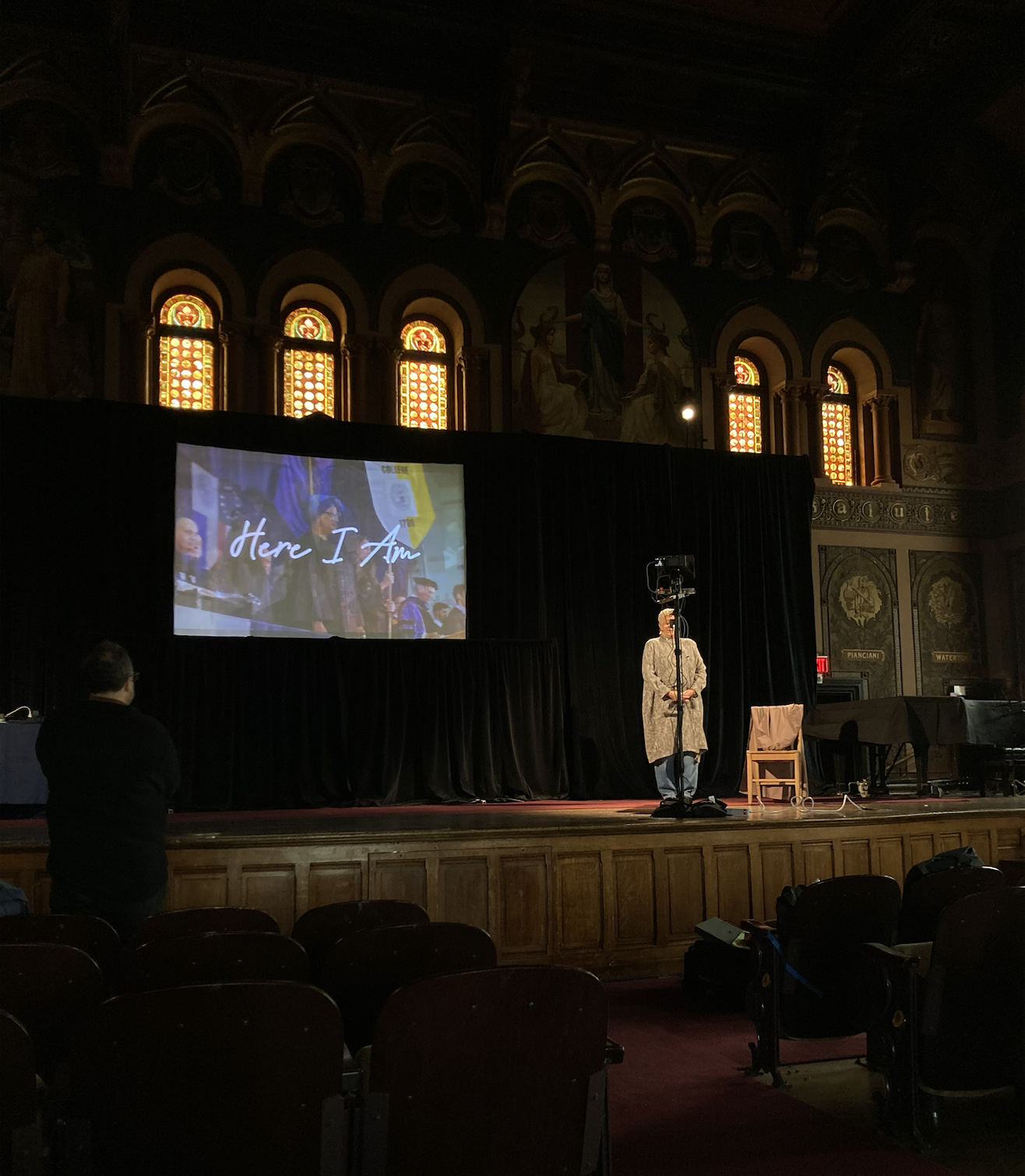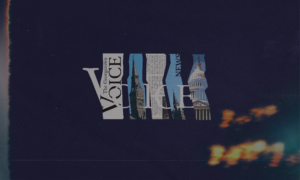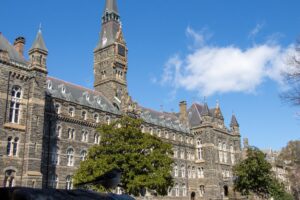“We’re continuously walking on graves. The earth itself is somebody’s grave,” Mélisande Short-Colomb (CAS ’21) recalled her father’s words while standing on the stage in Gaston Hall, during the inaugural live performance of Here I Am on April 4.
The show, through poignant lines and provocative questions, asks the Georgetown community to confront their own history and entanglement with enslavement and human trafficking and with that legacy the graves they may be walking on.
Here I Am has been in development in one shape or another since Short-Colomb, a descendant of the GU272, discovered her family’s connection to Georgetown and chose to enroll at the university in 2017.
“Here I Am really began before I came to Georgetown when I began to be looped into the larger story in realizing that I carried my family’s story, and it was me,” Short-Colomb said in an interview with the Voice.
She wrote, produced, and performed the one-woman show in conjunction with the Laboratory for Global Performance and Politics, where she serves as the community engagement associate. Short-Colomb co-directed the performance with Professor Derek Goldman, the chair of the Department of the Performing Arts.
The show explores Short-Colomb’s personal and familial connection to Georgetown. It tells what Short-Colomb aptly terms as “the rest of the story.” This is history that is both deeply personal to her, as much as it is a refutation of an institutional narrative Georgetown has long hidden about its origins. Most importantly, it is history that is very much alive, she notes.
“I’m a house of many rooms, occupied by my ancestors. I say in the piece, ‘I know I can depend on my ancestors,’ they prayed for me, brought me here, guided me, and they can depend on me,” Short-Colomb said. “So part of what I do every time I tell the story or interact with what I wrote is to go back to that inside of me. I’m the instrument. I’m the vehicle. ”
Here I Am has an incredible set of multimedia elements that help to bring her story to life. Throughout the performance, a camera pointed at Short-Colomb projected onto a larger backdrop. This backdrop screen alternates between displaying the live video of Short-Colomb or clips and images from various important moments: a video from Short-Colomb’s graduation, images of White Marsh Cemetery in Maryland, where many of the people enslaved on the Jesuit Plantations that helped fund Georgetown are buried, and a scrolling list of names of the GU272+. These images are mixed live by Jared Mezzocchi, a director, theater projection designer, and associate professor at the University of Maryland College Park.
This simultaneous combination of live multimedia elements on stage with Short-Colomb’s performance creates the feeling that the show is truly alive, that it’s happening right here, right now. It is this feeling that helps Here I Am to powerfully underscore that this is living history—it might have happened decades ago, but continues to reverberate into the present and significantly shape the lives of everyone associated with the university. These multimedia elements also add an impressive number of visual layers to the show, paralleling the multilayered nature of this story—personal, familial, and institutional. Displaying profound intentionality, Here I Am matches its medium to its message.
“This history is not a stagnant thing, it is a progressive and living thing in which we are all marking our places,” Short-Colomb said. “We are history, we are part of history. In the process of being reflective and being able to look back upon and know things that have happened, the other side of that is one day, you too, will be part of that long and distant past upon which people reflect and look back.”
Preparations for Here I Am initially began pre-pandemic. The project premiered virtually during COVID, via Zoom, in April 2021. Without the presence of an in-person audience, the show adapted its layered multimedia method of storytelling as a way to reimagine what live theater could look like in the Zoom space. Now, as the show moves off-screen and onstage, audience members are able to interact with and interpret the show’s elements differently.
For Short-Colomb, the prospect of having an in-person audience and with it a physical space to be performed allows for the presence of her ancestors to be felt. The definition of a multilayered performance is expansive; in Short-Colomb’s eyes, she sees the negative space that live theater creates as full of spirits.
“Here in the live space, we’re on many dimensions, we’re everywhere. I believe that what we perceive as empty is full of the spirits of our ancestors, and everybody is watching in that multidimensional way,” Short-Colomb said.
Goldman similarly sees the prospect of a live audience as another avenue to more fully realize the purpose of the show—namely, generating a feeling of collective responsibility and community amongst the audience.
“At core, the piece is really so much about the community. The gesture of the piece is kind of a handing off of not only an incredible story but of a sort of sense of community responsibility and engagement to a body of people,” Goldman said.
Goldman believes live theater allows audiences to feel both connected to the piece but also each other, a feeling that can’t be generated over zoom when audience members are physically separate. In this vein, the piece has also begun to directly include the audience through a ritual that Short-Colomb performs on stage that includes a call and response from the audience.
“Part of what we’ve built in the piece, that couldn’t work before, are moments that depend on the sort of liveness and presence of the audience,” Goldman said.
Short-Colomb was happy to bring her history live to Gaston Hall on the show’s opening day.
“The live performance, it was great, I felt very present, and comfortable,” Short-Colomb said. “The audience was great and warm, and I felt very well-connected to the audience and the people who were there and Jared, and Derek, and the team, and it was beautiful.”
This performance wasn’t Short-Colomb’s first time on the Gaston stage. In Oct. 2017, she gave a TED Talk about her personal connection to the university’s legacy on the same stage as an undergraduate student, soon after her matriculation.
“I was standing up on the stage yesterday and I remember how big the room felt then in 2017 and how small it’s gotten. It felt sort of like when I was a kid, and you go back into a space that you occupied before, and you’ve grown,” Short-Colomb said. “The space is exactly the same, but I’ve become more expansive, more spacious, I’ve grown over the last five years here at Georgetown.”
As Short-Colomb has grown, so has Here I Am, but at its core the show continues to keep her ancestors alive and tell the full story of her family and our history. Ultimately, it is this desire to give voice to those ancestors that gives her the motivation to continue to perform and share her family story with our community.
“My humble pride is that I can do this and connect with people and tell this story of my family, but in the much wider context of certainly Georgetown and the Jesuits, but also who we are as Americans,” said Short-Colomb. “I’m so proud that I can do this because, you know, who knew – I never saw this coming – but these years have passed and here we are.”
The next performance of Here I Am is April 12 in Gaston Hall.





